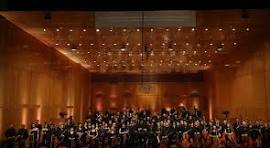Symphony Orchestra of India
Conductor Richard Farnes
Soloist Marat Bisengaliev
Fairfield Halls, Croydon
05 December 2023
John Williams’s The Imperial March from Star Wars is a good concert opener/warm up. Richard Farnes ensured that we got the measure of this fine orchestra immediately with all heavy down bow work and grand statements from the brass.
SOI was founded in 2006 by its chairman Khushroo N Suntook and tonight’s soloist violinist Marat Bisengaliev. Based in Mubai, it recruits from all over the world. I went to the concert largely out of curiosity and I’m very glad I did because the quality was outstanding. And it’s interesting to see and hear, a band whose players are predominantly Indian, playing with a British conductor.

The Khachaturian Violin Concerto in D minor, written for David Oistrakh in 1940 was an intriguing choice and if there’s a stereotypical look for a violin virtuoso then Bisengaliev confounds it. Hunched and bespectacled in a comfy overshirt, he doesn’t go in for showy gestures. He just plays every note – and there are a lot of them – with insouciant accuracy and warmth. I particularly admired the bassoon and whispering violas in the second movement and the way the first violins shaped their notes at their entry before the solo muted line from Bisengaliev which was evocative and richly mysterious.
For his encore, Bisengaliev was joined at the front by a flautist from the orchestra with a wooden flute. Accompanied by the orchestra they played the very pretty The Wooing of Etain by Karl Jenkins – complete with elegantly delivered legato notes from the flute and gentle double stopped glissandi from the violin.
But the best bit came after the interval in the form of Tchaikovsky’s 6th symphony “The Pathetique”. I have known and loved this most anguished of symphonies since I was a geeky teenager borrowing LPs from the library, but it’s a while since I heard a live performance. It is isn’t quite such a popular programme choice as it once was and I was faintly surprised that SOI chose it rather than something closer to home, but I’m delighted that they did because their performance was a sumptuous, rewarding treat. I suspect Richard Farnes loves it as much as I do because he certainly dug out the passion.
Highlights included the perfect balance between the pizzicato descending scales in the strings and the trombones at the end of the first movement. Then we lilted lovingly (beautiful playing from violas and cellos at every stage of this concert, by the way) into that strange 5|4 “waltz” whose lopsided oddness, tuneful as it is still conveys unease.
The huge, manic Allegro molto vivace, which always fools half the audience into thinking it’s the end of the symphony, was played with an attractive combination of delicacy and strength. The rapid string sections were crisp and the cymbal clashes, perhaps my favourite moments in the whole work, suitably dramatic.
And so to that brooding, introspective concluding adagio into which Farnes moved swiftly to curtail the intrusive applause. The bassoon solo was arresting, the heart breaking main melody delivered with compelling emotion and Farnes really leaned on the general pauses which was effective. Happily, too, he managed to hold the silence at the end as the sound of the very quiet ending died away.
It is a great pity – and presumably disappointing for the orchestra – that the hall was barely a quarter full for this impressive and enjoyable concert. A lot of people missed something really quite special.
